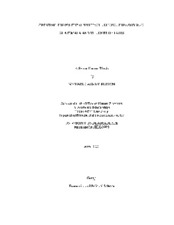| dc.creator | Burton, Michael Cassidy | |
| dc.date.accessioned | 2013-02-22T20:40:00Z | |
| dc.date.available | 2013-02-22T20:40:00Z | |
| dc.date.created | 2000 | |
| dc.date.issued | 2013-02-22 | |
| dc.identifier.uri | https://hdl.handle.net/1969.1/ETD-TAMU-2000-Fellows-Thesis-B865 | |
| dc.description | Due to the character of the original source materials and the nature of batch digitization, quality control issues may be present in this document. Please report any quality issues you encounter to digital@library.tamu.edu, referencing the URI of the item. | en |
| dc.description | Includes bibliographical references (leaves 34-35). | en |
| dc.description.abstract | The political spectacle is a show and a way of seeing things. In effect, the media reduces politics to theatre, simplifying complex issues into a world of black and white, where leaders compete with an enemy for influence over a social problem. On another level, the spectacle is a looking glass, used by politicians to distort the public's view of the world in order to maintain their own power. The political spectacle is more than an individual's interpretation of events, however. It is a social construction that has developed over a long period of time in which "the observer and what they observe construct one another" in an attempt to bring order to and make sense of reality. The political spectacle is created by the way leaders, enemies, and social issues interact with one another and reconstruct one another over time. Furthermore, some social constructions of reality are better than others. Good policymakers and citizens have a responsibility to step back and critically evaluate the political spectacle and determine if it created based on reliable evidence or assumptions. When the observer attempt to deconstruct the political spectacle and look at it from multiple perspectives they can reach a more complete understanding of the event. The objective of this research is to show how the interaction between the United States and Guatemala during President Arbenz's tenure in power is a good example of Edleman's political spectacle. Depending on how US policymakers interpreted Arbenz's policy decisions and actions determined if he was perceived as an enemy of the United States or a reformist leader. The accepted interpretation had important ramifications on government policy, the future of Guatemala, and ultimately human life. Regardless of whether an individual believes the Eisenhower Administration made the right or wrong decision about Arbenz, policymakers and concerned citizens need to be aware of the political spectacle and its mystifying properties, and attempt to evaluate their own positions and their political leaders in terms of it. Hopefully, this analysis of events will provide an example for how this can be done. | en |
| dc.format.medium | electronic | en |
| dc.format.mimetype | application/pdf | |
| dc.language.iso | en_US | |
| dc.publisher | Texas A&M University | |
| dc.rights | This thesis was part of a retrospective digitization project authorized by the Texas A&M University Libraries in 2008. Copyright remains vested with the author(s). It is the user's responsibility to secure permission from the copyright holder(s) for re-use of the work beyond the provision of Fair Use. | en |
| dc.subject | economics and political science. | en |
| dc.subject | Major economics and political science. | en |
| dc.title | Creating the political spectacle during the Cold War: Guatemala and the United States | en |
| thesis.degree.department | economics and political science | en |
| thesis.degree.discipline | economics and political science | en |
| thesis.degree.name | Fellows Thesis | en |
| thesis.degree.level | Undergraduate | en |
| dc.type.genre | thesis | en |
| dc.type.material | text | en |
| dc.format.digitalOrigin | reformatted digital | en |


